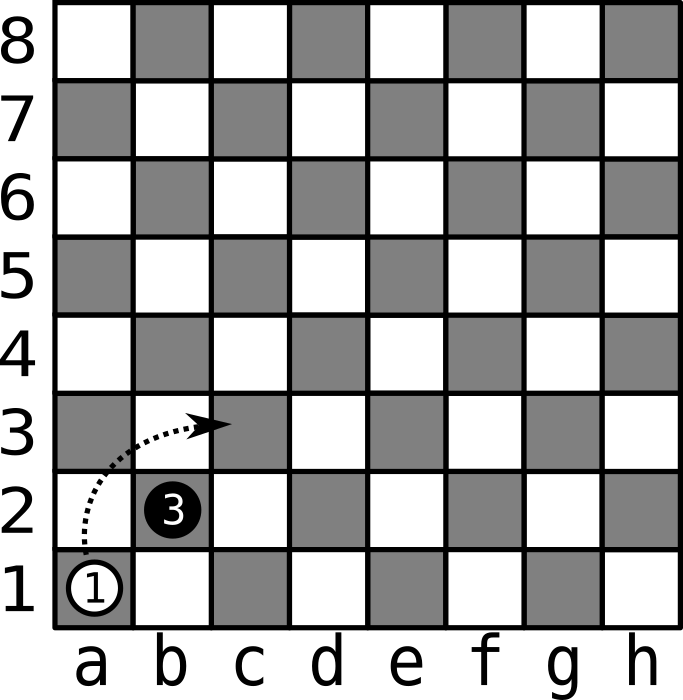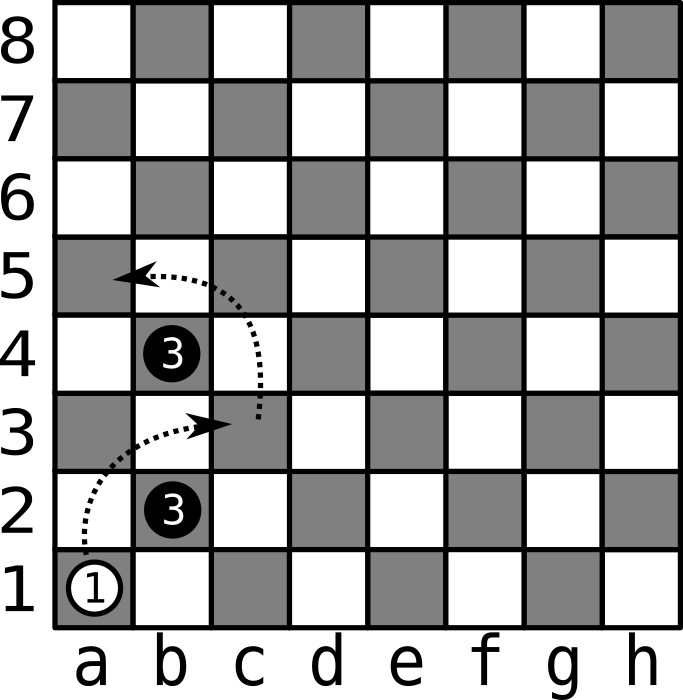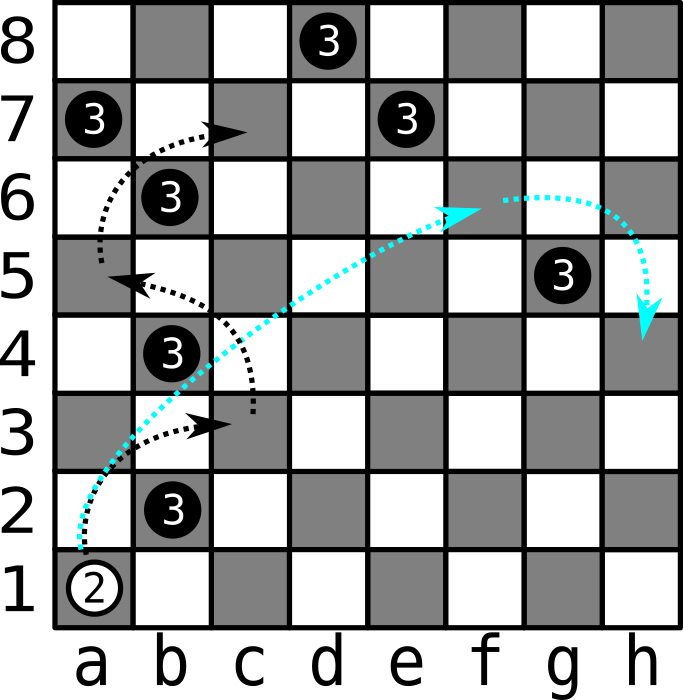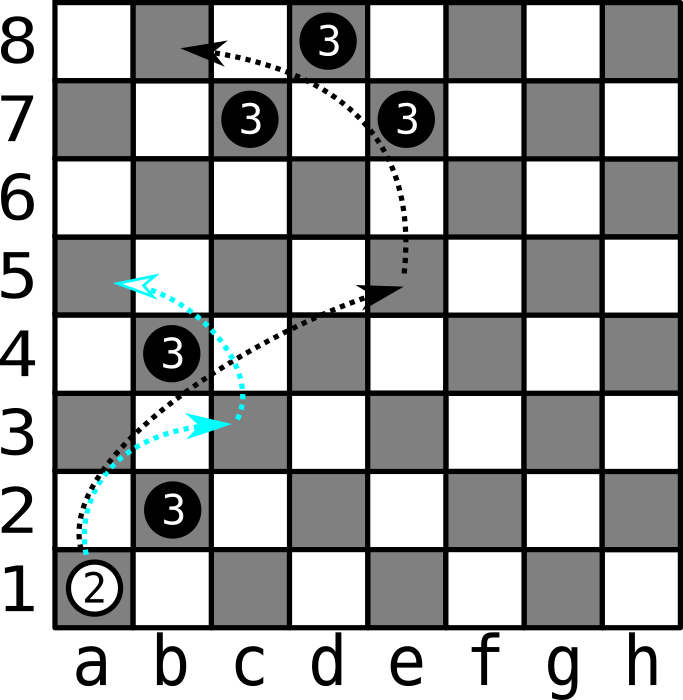Table of Contents
Cvičení 5: 2D pole
Dvojrozměrné pole
- Ukázka “pole polí”:
x = [[0, 1], ['a', True], [1, 1.0, 2, 4]] >>> len(x) 3 >>> len(x[0]) 2 >>> x[1][1] True >>> type(x) <class 'list'> >>> type(x[0]) <class 'list'>
- Vytvoření nulové matice o rozměrech 2×3:
x = [] for i in range(2): x.append([0] * 3) >>> print(x) [[0, 0, 0], [0, 0, 0]]
Výpis matice
- Napište funkci
printMatrix, která vypíše matici zadanou 2D polem - Prvky budou odděleny mezerou a každý řádek bude vypsán na nový řádek
- Kromě prvků matice nebude vypsán žádný jiný znak
Stopa matice
- Napište funkci pro výpočet stopy matice
Násobení vektoru a matice
- Napište funkci
multiVecMat(v,m), která vypočte součin vektoru $v \in \mathbb{R}^{N}$ a matice $m \in \mathbb{R}^{N \times N}$. - Pokud nesouhlasí rozměry matice a vektoru, pak funkce vrací
None. - Vypočtete výsledek násobení $m \cdot v$:
m=[[0,0,1],[0,1,0],[1,0,0]] v=[2, 4, 6]
Načtení 2D pole ze souboru
- Načtení matice uložené v souboru. Na každém řádku v souboru je uložen jeden řádek matice. Čísla jsou oddělena mezerou.
- Vstupní soubor (matice.txt)
1 2 3 4 0 5 7 -1 2
- Soubor matice.txt musí být “viditelný” pro váš skript (pokud ne, je třeba zadat absolutní cestu k souboru).
pole=[] f=open('matice.txt','rt') for line in f: pole.append(list(map(int, line.split()))) f.close() print(pole)
- Program vypíše
[[1,2,3],[4,0,5],[7,-1,2]]
Načtení zakódovaného obrázku ze souboru
- Stáhněte si soubor encoded.txt, jenž obsahuje zakódovaný obrázek. Každý řádek obsahuje různý počet dvojic znak+číslo (např.
#2) oddělených mezerou. Pro zobrazení obrázku se musí tyto dvojice prvně dekódovat. - Pročtete si a porozumějte tomutou kódu a poté ho spusťte.
## | ------------------ Functions definition ------------------ | # [You should understand this function] # Function loading given file def loadFile(filename): mat = [] # create empty list f = open(filename, 'rt') # open file with name 'filename' in 'read' and 'text' modes for line in f: # iterate all lines in the file # parse single line from file: # 1) strip: remove spaces and new line characters from beginning and end of the line # 2) split: split line by spaces, returns list # 3) map: maps each element to string # 4) list: convert output of map to list of strings lst = list(map(str, line.strip().split(' '))) mat.append(lst) # append list to our 'mat' variable f.close() return mat # [You don't need to understand this function] # Function decoding our file def decode(mat): mat_decoded = [] # create empty output list for lst in mat: # for each list in 'mat' (list of lists) decoded = '' # initialize the decoded string to empty value for s in lst: # for each encoded value in list 'lst' char = s.rstrip('0123456789') # cut the numbered part of our string out, example: #2 -> # num = s[len(char):] # retrieve the cut part, example: 2 if char == 's': # space is encoded as 's' char = ' ' # replace 's' by space character decoded = decoded + int(num) * char # decode and store into 'decoded' variable mat_decoded.append(decoded) # append single decoded line into our output list return mat_decoded # return output list ## | -------------- Python starts processing here ------------- | encoded = loadFile('encoded.txt') # load the encoded file decoded = decode(encoded) # decode the encoded file for line in decoded: # print our decoded file print(line)
Témata k procvičení
Implementujte následující úlohy:
- Funkce, která v matici najde všechny záporné hodnoty, vraťte seznam jejich indexů
- Funkce pro násobení dvou matic
- Funkce pro výpočet determinantu matice
Domácí úkol
Lehká varianta
- Napište program dama_tah.py, který načte matici celých čísel ze souboru, jehož jméno je zadáno jako první argument programu sys.argv[1] a zjistí, zda existuje bílý kamen, který může skočit přes nějaký černý kámen. Pokud takový kámen existuje, pak vypíše tah bílého v šachových souřadnicích.
- Vstup:
- První argument programu obsahuje jméno souboru.
- Soubor obsahuje matici $ 8 \times 8 $ - celých čísel s tímto významem:
- 0 - volné pole
- 1 - bílý kámen
- 2 - bílá dáma
- 3 - černý kámen
- 4 - černá dáma
- Pole na šachovnici odpovídají tomu, že první řádek matice představuje řadu 8, druhý řádek reprezentuje řadu 7, … , poslední řádek v souboru reprezentuje řádek 1. Sloupce jsou označeny písmeny a,…,g.
- Úkol:
- Bílý je na tahu a program najde kamen, který může skočit.
- Na šachovnici je v této úloze vždy jen jeden kamen, který může skočit.
- V tomto programu lehké varianty uvažujte pouze pohyb bílého kamene, šachovnice nebudou obsahovat bílou dámu. Tah odpovídá pravidlům České dámy (Dáma (desková hra))
- Bílý kámen se pohybuje pouze “nahoru”, tedy pouze směrem k vyšším číslům řad.
- Kameny se pohybují po úhlopříčkách na sousední volné pole.
- Kamen může skočit, pokud je sousední pole obsazené cizím kamenem nebo dámou a následující pole za obsazeným polem je volné, pak kamen může skočit na volné pole a cizí kamen je z šachovnice odstraněn.
- Pokud kamen po skoku může ještě jednou skočit, pak lze tento skok také provést a opakovat skok, dokud je možné skákat.
- Výstup:
- Program vytiskne na jeden řádek souřadnice kamenu, který skočil a všechna místa, kam skočil (míst je víc pro vícenásobný skok)
- Příklad pro výše uvedené šachovnice bude výstup programu:
a1 c3a1 c3 a5
- Program v souboru dama_tah.py odevzdejte pomocí odevzdávacího systému (úloha HW05).
- Můžete předpokládat, že všechny matice jsou zadány korektně, tedy všechny řádky mají stejný počet prvků.
- Pokud se vstupní soubor jmenuje
dama.txt, Váš program můžete spustit příkazempython3 dama_tah.py dama.txt. - Soubor s šachovnicí můžete otevřít takto:
import sys sachovnice = open(sys.argv[1], "rt")
Příklad
- Soubor dama.txt obsahuje:
0 0 0 0 0 0 0 0 0 0 0 0 0 0 0 0 0 0 0 0 0 0 0 0 0 0 0 0 0 0 0 0 0 0 0 0 0 0 0 0 0 0 0 0 0 0 0 0 0 3 0 0 0 0 0 0 1 0 0 0 0 0 0 0
Výstup:
a1 c3Vysvětlení: Šachovnice obsahuje pouze dva kameny, jeden bílý, jeden černý. Bílý skočí černý kámen skokem z pole
a1 na pole c3.
- Soubor dama.txt:
0 0 0 0 0 0 0 3 0 0 0 0 0 0 4 0 0 0 0 0 0 1 0 0 1 0 3 0 3 0 4 0 0 3 0 0 0 0 0 0 1 0 0 0 4 0 0 0 0 3 0 3 0 0 0 1 1 0 1 0 0 0 0 0
Výstup:
a1 c3Vysvětlení: Šachovnice obsahuje pouze mnoho kamenů, ale kromě kamenu na poli
a1. Například kamen z pole a3 nemá za černým kamenem na poli b4 volné pole c5, bílý kamen z pole h2 nemá černý kámen na poli g3, bílý kamen z pole f6 by mohl skákat pouze zpět a to není v České dámě dovoleno.
- Soubor dama.txt:
0 0 0 0 0 0 0 3 0 0 0 0 0 0 4 0 0 3 0 0 0 1 0 0 0 0 3 0 3 0 4 0 0 3 0 0 0 0 0 0 1 0 0 0 4 0 0 0 0 3 0 3 0 0 0 1 1 0 1 0 0 0 0 0
Výstup:
a1 c3 a5 c7Vysvětlení: Kamenu z pole
a1 skočí nejdříve na pole c3, dále pokračuje skokem na poli a5 a ještě může pokračovat skokem na pole c7.
Těžká varianta
- Nejdříve si přečtěte zadání lehké úlohy.
- Napište program dama_max.py, který načte matici celých čísel ze souboru, jehož jméno je zadáno jako první argument programu sys.argv[1] a najde kamen (obyčejný kamen, nebo dámu) která může provést nejdelší skok. Délku skoku určuje nejdříve počet kamenů černého, které při skoku zajme. V přípedě, že dva různé skoky zajmou stejný počet černých kamenů pak o délce skoku záleží na počtu políček, které kamen při braní urazí.
- Pokud existují skoky se stejnou délkou, vytiskněte libovolný z nich.
- Vstup:
- První argument programu obsahuje jméno souboru.
- Soubor obsahuje matici $ 8 \times 8 $ - celých čísel s tímto významem:
- 0 - volné pole
- 1 - bílý kámen
- 2 - bílá dáma
- 3 - černý kámen
- 4 - černá dáma
- Pole na šachovnici odpovídají tomu, že první řádek matice představuje řadu 8, druhý řádek reprezentuje řadu 7, … , poslední řádek v souboru reprezentuje řádek 1. Sloupce jsou označeny písmeny a,…,g.
- Úkol:
- Bílý je na tahu a program najde kamen, který provede nejdelší skok.
- Uvažujte všechna pravidla České dámy (Dáma (desková hra))
- Oproti lehké variantě přidáme pohyb dámy. Dáma se pohybuje úhlopříčně libovolným směrem.
- Dáma může skočit, pokud jsoou na diagonále volná pole a hned za nimi sousední pole obsazené cizím kamenem nebo dámou a následující pole za obsazeným polem je volné, pak dáma může skočit na libovolné volné pole za cizím kamen.
- Cizí kamen (nebo kameny) se odstraní, až když tah dámy skončí. Cizí kamen lze přeskočit při jednom tahu pouze jednou.
- Jak bylo uvedeno výše, délka skoku závisí nejvíce na počtu braných kamenů, v případě shody v počtu braných kamenů rozhoduje počet polí, která dáma, nebo kamen musel překonat (i když to vede k nevýhodné situaci pro bílého).
- V následujících obrázcích jsou černě značeny nejdelší skoky, modře skoky kratší:
- Výstup:
- Program vytiskne na jeden řádek souřadnice kamenu, který skočil a všechna místa, kam skočil (míst je víc pro vícenásobný skok)
- Program v souboru dama_max.py odevzdejte pomocí odevzdávacího systému (úloha HW05).
- Můžete předpokládat, že všechny matice jsou zadány korektně, tedy všechny řádky mají stejný počet prvků a obsahují pouze celá čísla od 0 do 4.
Příklad
- Soubor dama.txt obsahuje:
0 0 0 0 0 0 0 0 0 0 0 0 0 0 0 0 0 0 0 3 0 0 0 0 0 0 0 0 0 0 0 0 0 3 0 0 0 0 0 0 0 0 0 0 0 0 0 0 0 3 0 2 0 0 0 0 0 0 1 0 0 0 0 0
Výstup:
c1 a3 c5 e7Vysvětlení: Skok bílého kamene je delší než skok bílé dámy.
- Soubor dama.txt:
0 0 0 0 0 2 0 0 0 0 3 0 3 0 4 0 0 0 0 0 0 0 0 0 0 0 3 0 0 0 3 0 0 0 0 0 0 0 0 0 0 0 0 0 3 0 3 0 0 0 0 3 0 0 0 0 1 0 1 0 0 0 2 0
Výstup:
g1 d4 b6 d8 f6 h4 e1 c3 h8Velmi dlouhý skok dámy.
- Soubor dama.txt:
0 0 0 0 0 4 0 0 0 0 3 0 0 0 3 0 0 2 0 0 0 0 0 0 0 0 0 0 3 0 0 0 0 0 0 0 0 0 0 0 0 0 3 0 0 0 3 0 0 1 0 0 0 0 0 1 0 0 0 0 0 0 0 0
Výstup: buď
b2 d4 f6 h8nebo
h2 f4 d6 b8Dva stejně dlouhé tahy, Váš program vytiskne buď první nebo druhý tah.



